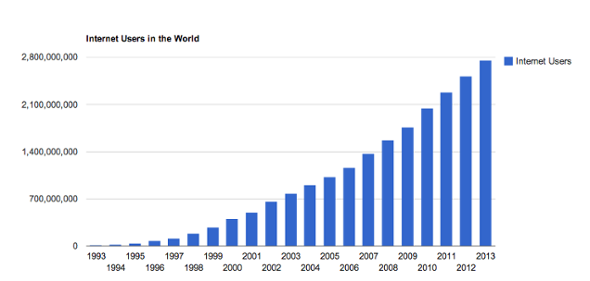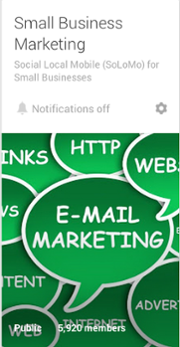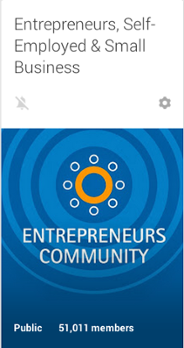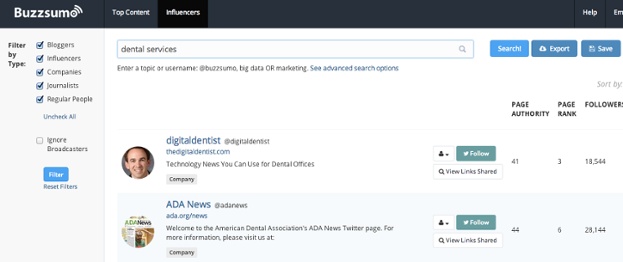[display-name-category]
[post_author]
As a business owner, there are several aspects you have to monitor, develop, and improve on a day-to-day basis.
Marketing is one of those aspects, and we are shocked to see a lot of small to medium-sized businesses neglecting it.
To make your lives easier, I have covered six basic areas you need to consider to have a successful marketing strategy.
You don’t have to implement all of these tactics simultaneously; you can start with two or three aspects that best fit your business needs.
1. Don’t Be Afraid of PPC
According to research, 38.5% of the world’s population uses the Internet; we are talking about 2.7 billion people in the world. And this trend will only increase as new generations are born into this era and older people adapt to new technology.

Internet users in the world
You can read more about the incremental use of the Internet and its explosive adoption in the past 25 years in this study by Pew Research.

Technologies that would be very hard to give up
What makes Pay per Click so attractive and effective is that it allows you to reach your potential customers in a massive way and in a matter of minutes.
Is Your Business Taking Advantage of this Opportunity?
Online brand awareness has become crucial for businesses to succeed in today’s economy. Paid Search allows you to talk directly to the right customer for your product or service at the right time in the right location, and across all different devices.
It’s all about staying top of your potential customers’ minds. Traditional marketing channels such as TV, newspaper, and radio are not cutting it anymore. In such an ad-polluted market, you have to rise above the noise to call your prospects’ attention.
To learn the basic steps to implement Search Marketing, these articles will help you get started:
– Pull Marketing vs Push Marketing: Definition, Explanation & Benefits by Gary Garth.
– How Much Should a Small Business Spend on Marketing? By Gary Garth.
2. Content Marketing: Start Blogging Now!
Blogging gives you a voice and an online presence. It is a window for your business to share with the world why your business rocks.
It’s easy to say “you need to start writing to attract visitors”, truth is that writing requires time, resources and expertise. But the rewards are plentiful when it’s done right.
Blogging has a positive psychological effect on your prospects and customers. Think of it as a “public newsletter”. It allows you to share your knowledge, nurture your relationship with existing customers, and position yourself as an expert for prospects.
Consistency Is Key
Start with a post per week of a maximum of 1,000 words. Write about the information your customers crave:
- FAQs (customer inquiries)
- Product/service troubleshooting
- Customer objections to your product/service
- Industry best practices
You will quickly realize that 4 posts a month will go a long way and that you will need to blog more frequently or perhaps write lengthier posts.
You can use these posts to validate your status as an authority in your industry. Additionally, blogging is a great alternative to get inbound leads if you can’t afford a telemarketing department or a large sales force.
3. Leverage Google+: Join Communities
The beauty of Google+ is that it helps you improve your search rankings by just being active and posting content. Once you start blogging, you can set up Google authorships to link your content to your Google+ profile.
For more details on how to set up Google structured data, follow these steps.
Furthermore, Google My Business is a great place for networking opportunities, mentorship, and business partnerships as well as a source of inspiration and great content.
As a business owner, you can join communities related to your business to keep up with industry trends and news.



4. Social Media Tools for Automation and Monitoring
Content promotion is as important as content creation. Once people read and interact with your content, how will you keep them engaged with your brand? How are you going to direct them to take action and hire you?
Pick the Right Social Media Channel for Your Business
Before I start with this point, I am assuming you already have social media channels that you use to distribute, curate content, and promote your services. You don’t have to use all social media networks available. Pick the ones that cater to your needs.
For example, if you run a retail store, you would leverage Pinterest more than an accounting firm would. In this case, you would need a venue that communicates the visual features of your product or service, whereas the accounting agency will benefit more of a channel like LinkedIn that allows for networking and keeping up with the best practices.
Segment Your Social Media Usage by Purpose
You can also segment your social media usage by purpose. For example, Facebook may allow you to keep in touch with active customers, LinkedIn may be more effective for recruiting and building a professional network, and Google+ may help you build a community and find prospects.
Now that we got that out of the way, you can pick the right tools to manage all the different social media channels you use.
Be Strategic About the Social Media Tools You Use
There are very cool tools out there to monitor social media, but that doesn’t necessarily mean you have to use them all.
I am not a fan of companies that promise they will grow your social media following in a short period of time. It just doesn’t work that way. The process of creating a following is somewhat painful and it takes time.
You want to create a follower base that is loyal, that genuinely enjoys your tweets, and think of you as a source of knowledge.
These following tools can be used alone, but I have found the most effective when paired together to grow followers, curate content, and monitor engagement. For the most part, these tools work just fine in the free version, it will depend on your needs if you want to upgrade.
Twittonomy and BuzzSumo: Identify Influencers and Grow Your Following
This killer combo will help you grow followers the right way.
BuzzSumo is very helpful in identifying competitors and influencers. It pretty much works as a ranking of the authorities in your industry.

Twittonomy lets you analyze influencers/ competitors’ Twitter profiles, followers, tweets, and behavior in general. So you can strategically emulate their behavior and create a list of their main followers.
You can then add those followers to specific lists, and I guarantee you that at least 50% will follow you back. Think about it, if they are already following a company similar to yours, the chances of them following you are very high.
HootSuite and Comun.it
Hootsuite The cool thing about this app is that is a more integrated platform that lets you monitor different social media streams (Facebook, Twitter, LinkedIn, Google, WordPress, etc.). Perhaps the biggest perk is that it allows you bulk schedule tweets and posts for all these different accounts. The app shows you the streams for your different accounts, but it lacks in nurturing followers and identifying top influencers.
Commun.it tracks and nurture your existing followers; it identifies your supporters, potential followers, and active conversations on Twitter. It is not that easy to keep with all of these activities on Twitter, and Commun.it does a great job at doing it for you.
Buffer and Feedly: A Match Made in Heaven
It is not enough to share your own content; you also have to be active in your niche market, share other influencers’ posts, and generate conversation about what’s happening in your industry.

Feedly will help you find those articles and news that are relevant to your business. You can create a personalized feed and handpick the different blogs and sites that share the content you are interested in.

Buffer is a brilliant tool that lets you schedule posts and publishes them at the time your social media community is most active. You can add several accounts and have different schedules for all of them… and the best part is you don’t have to be attached to your computer to share them. It really is a beautiful thing.
5. Get professional with LinkedIn
A lot of people have a LinkedIn profile and they never do more than adding their professional experience and connecting with others.
LinkedIn provides business owners the opportunity to engage followers and potential leads in a highly effective manner, more effective than Facebook and Twitter, I dare to say.
LinkedIn Groups: More Conversions, Fewer Impressions
Just like Google+, LinkedIn also has the option to join groups/networks. The difference is that these groups are more specialized groups in various lines of businesses, with the plus that group users are highly collaborative and provide professional advice when required…for free.
Additionally, LinkedIn has proven to be more efficient to build following, with fewer content impressions and interactions, but surprisingly more engagement and conversions in return.
Just to give you an example, we spend 50% less time on LinkedIn posting and monitoring comments, and we get a 50%+ conversion rate than Facebook and Twitter.
If you ask me how you should prioritize your social media accounts, which ones are the most important? I would say it depends on your line of business. In my personal experience, LinkedIn and Twitter are the most important, in that respective order.
6. Pay attention to Mobile Optimization
As my colleague, Ana Morales stated in her post, ” We’re in 2014 and it’s time for you to have a mobile-optimized website! Whether you are trying to bring in new customers or keeping your existing ones happy, you must have one.”
There is nothing worse than trying to navigate a website on your phone that is not mobile optimized. Patience only goes so far, and I know from experience that I will not spend much time on my phone zooming in and out to decipher your website.
Invest in your website’s mobile responsiveness; only then you will leverage $31B dollars projected to spend in mobile sales in 2015.
Wear the Chief Marketing Officer Hat
You have to wear many hats as a business owner, being the chief marketing officer should be one of the most important roles you have to fulfill to run a successful business.
As you experience the success of implementing these tactics and your business expands, you will have enough resources to delegate these tasks in the future.
Like I said at the beginning of this post, you can start with one tactic, and you will quickly see how all the other pieces will fit in the puzzle. It’s just a matter of taking the first step and implementing a complete marketing strategy.
What other marketing tactics would you add to this list? If you have already implemented one, tell us about your experience and how it impacted your business.
Graphs credit:
1. Percentage of internet users around the world. Credit to Internet Live Stats. 05/07/2014.
2. Incremental use of the Internet. Credit to Pew Research Center. 05/07/2014.






